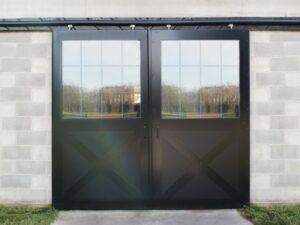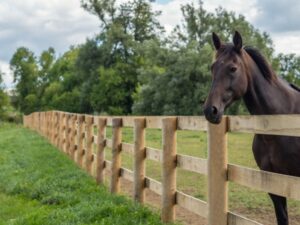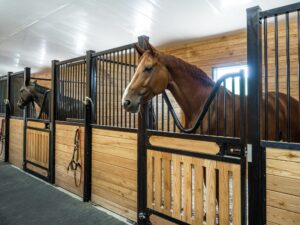Many horse owners would agree that their horse is happiest when outside. A paddock can provide a clean, safe and controlled area where your horse can get some exercise, socialize and enjoy being outside. If you are planning to design and build a paddock, it’s very important that it is the right size and made from the right materials. In this article, we review the different factors that should be taken into consideration when planning and building a paddock for your horses, to create the safest environment possible.
Paddock Sizing Guidelines
Before buying or agreeing to become responsible for a horse, you must first consider the costs, type of horse, time requirements, required skills and knowledge, contingency plans, and of course, how and where the horse will be kept. You must be able to provide the horse with proper accommodations, either at your home property or an off-site location, which generally includes a paddock. A paddock is defined as a small, fenced-in field or enclosure (with varying surface terrain) where horses are kept or exercised.
The National Farm Animal Care Council (NFACC) Code of Practice for the Care and Handling of Equines outlines the guidelines and requirements for paddocks in Canada. These guidelines help to ensure the health and safety of horses throughout Canada by regulating the standard for their care, facilities and housing.
It’s very important that horses are given enough time outside. Horses can adapt to most climates and weather conditions, making it much easier to give them the outside time that they require to stay happy and healthy. Horses are used to staying outside full time, rain and snow. As mentioned above, the paddock is a great resource for ensuring that your horse enjoys the fresh air and sunshine regularly.
The size of your paddock is extremely important. If a paddock isn’t big enough for the horse or horses within, the risk of injury can increase, as overcrowding can lead to competition for both space and resources. Generally, the minimum space allowance per horse in m2, is 2 to 2.5 times the height of the horse, at the withers, squared. Please note that these guidelines are merely a minimum and your horse may require more space if your property permits. Ideally, there should be more than enough room for the horses to canter at will.
Each horse should have enough space to move freely, walk forward, turn around, and lie down in a normal resting position. There should also be enough space for subordinate horses to escape aggression if need be. You may also have to consider if you have a stallion, horse or multiple horses with special needs, sick or injured horses, geriatric horses, or require an area dedicated to mares and foaling.
Planning Your Horse Paddock Size
It’s imperative that you plan for enough space based on the number of horses that you are looking to accommodate. Based on the regulations from the NFACC, in Canada the minimum space allowance per horse in m2, is 2 to 2.5 times the height of the horse, at the withers, squared. If you will have multiple horses, you must take each horse into consideration when planning the size of the paddock. In practice, the minimum size paddock for an individual turnout should be approximately 50’ x 50’. This would be a single turnout day paddock. If you want a paddock that will sustain the horses on grass, then you would like the paddock to not be smaller then one acre per horse, assuming you have enough rainfall to grow grass through the season. Or 43,560 sq ft. of area.
You will also have to consider the material used to build the paddock. Factors that may impact the kind of fence and material used to build the paddock can include the terrain, climate, budget, and kind of horses. Generally, we suggest using Flex Fencing for paddocks. Flex Fencing is created from durable material that is designed to stand up against a variety of elements. If a horse kicks or runs into the fence, the design allows it to absorb the impact and flex, returning to the original shape afterwards.
The benefits and features of Flex Fencing include:
- High-tensile galvanized steel wire with a bonded or trapped polymer around the wire
- Highly visible
- Flex 425 Fencing has a 30 year warranty, while Flex 525 Flexing has a lifetime warranty
- The rail is the strongest and most durable wide rail product on the market
- Reduces the risk of injury to your horse from splintering fence boards
- Absorbs impact and then returns to original form
This type of equine fencing is known and respected for being stylish, safe and functional, with no compromise on affordability or durability. Other kinds of fences for your paddock can include electric fences, wood horse fences, wire mesh fences and pole fences, among others. To learn more about the equine fence solutions available to you, contact us today.
Learn More About Paddocks and Paddock Fencing Today
To learn more about our fencing solutions, contact System Equine today. One of our specialists would be more than happy to help you build the right paddock for your equine barn and horses.
We proudly carry:
- Electric fencing
- Pasture fence
- Paddock fencing
- PVC horse fence
- Wood horse fence
- White horse fence
- Flex Fencing
- And many others!
Contact us or visit the rest of our website to get started today. Let’s create the best paddock for your horses.






